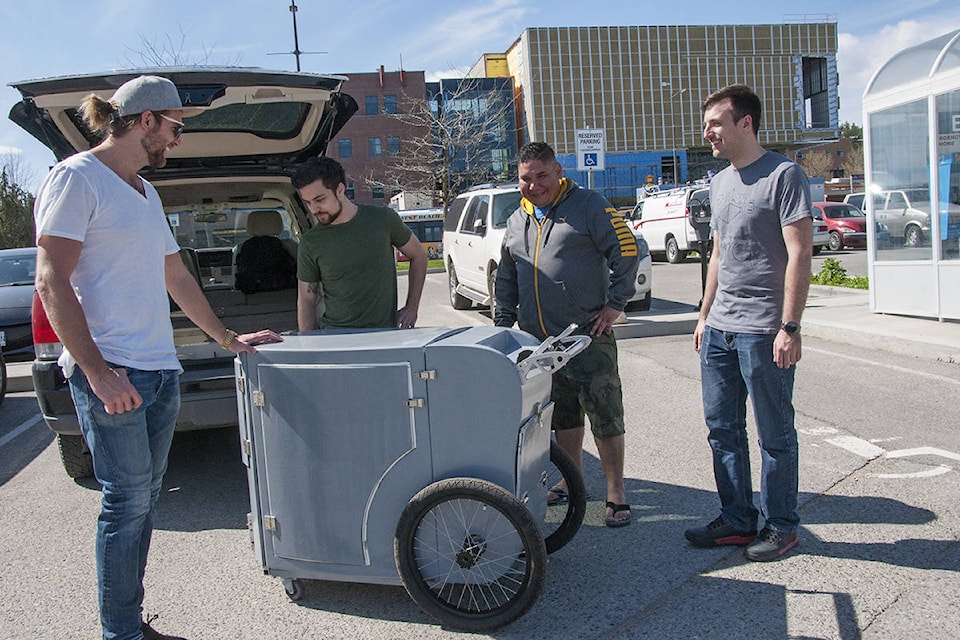It is not your everyday test drive.
The first-ever personal belongings carrier, specifically designed for homeless people, is ready to roll onto 91���Ѽ sidewalks.
What started as an idea from people experiencing homelessness and members of the Metro Community Church in the city, has evolved into a partnership with UBC Okanagan’s School of Engineering. The project to design personal belongings carriers has evolved into a long-term community undertaking that will make life easier for 91���Ѽ’s homeless, according to project engineer Bryn Crawford.
Crafted by faculty, staff and students at the School of Engineering, the carrier is partially constructed with composite materials designed in the Okanagan node of UBC’s Composites Research Network. The goal was to make something strong, yet light that could be easily manipulated along city streets.
“The project has continued to significantly evolve over the course of its lifetime,” Crawford said. “One of the largest and most rewarding challenges addressed so far, is to develop this carrier in a way that satisfies the needs of the entire community. The teamwork between all community stakeholders has been fantastic and has been a very valuable experience for all students involved.”
Last week, Crawford’s team handed the original prototype to representatives from Metro Community—a church comprised of people from all walks of life. The church provides a safe place for people struggling with homelessness, mental health challenges, addiction and poverty. The prototype will be given to a member of the street community to test drive on the streets and provide feedback to the engineers.
“We’re certainly excited to pick this one up and get it out on the streets for a test drive,” Metro’s Devon Siebenga said. “We have a couple members of our community in mind who will be able to use this and let us know how practical it is.”
The cart will allow homeless people to secure their belongings, normally stowed in shopping carts. The carts are lockable and users can leave them while they attend appointments, get a meal or access other support services. This first one, which can be dismantled into three lockable sections, is made of plywood and specialty designed composites, comes equipped with hand brakes, a removable bicycle hitch, a GPS unit, shelving inside each compartment and 3D-printed wheel hubs.
“Many of the people who live on the streets, live from minute-to-minute and stress about securing their belongings,” explained Siebenga. “This limits their ability to get a hand up and the problems further compromise their sense of stability and path to recovery. This personal belongings carrier is a first small step in restoring their dignity.”
After it was introduced by Metro Community two years ago, the project quickly evolved into a community venture with input from the church, UBC, the RCMP and the City of 91���Ѽ. Local manufacturer Waterplay Solutions contributed more than $9,500 in-kind to the project and the team received an Engage grant from the Natural Sciences and Engineering Research Council.
At the same time, first-year engineering students were tasked with designing a cart as part of their program, while fourth-year students investigated manufacturing aspects for their year-end project and graduate students explored composite building materials, while also introducing various functional sub-systems to make the carriers as practical as possible for users.
“Until we actually started building a cart, we didn’t know exactly what we needed to bring one to completion,” Crawford said. “It’s gone through several design stages, with materials such as plywood, aluminum tubing and fibreglass. Even this first model is significantly different, and a bit heavier than the next few we’ve got on the go.”
A stakeholder focus group will track the success of the carts once it gets feedback from the end users. Three other carts are currently being assembled by students while Crawford and Siebenga are looking at methods to get them streets as quickly as possible.
“The average person on the street has no desire to be there, nor do they want to use shopping carts. This provides a dignified alternative while they seek to get their lives back on track,” added Siebenga.
“In the long run, the hope is to see people engage in ownership of each cart, taking responsibility and using the opportunity to move towards a permanent housing solution, as they fret less about the security of their worldly belongings, and focus more on recovery, safety and housing.”
To report a typo, email:
newstips@kelownacapnews.com.
newstips@kelownacapnews.com
Like us on and follow us on .



